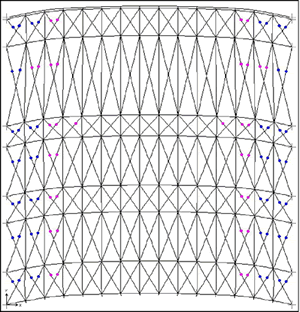| Project Title/ID Number |
Evaluation and Application
of Concrete Tilt-up Assessment Methodologies—509 |
| Start/End Dates |
4/1/03 – 3/31/04 |
| Project Leader |
James Malley (Degenkolb/I) |
| Team Members |
Tim Graf (Degenkolb/I), Jack
Hseuh (Degenkolb/I) |
F=faculty; GS=graduate student; US=undergraduate student; PD=post-doc; I=industrial
collaborator; O=other
Click on images to enlarge in a new window
1. Project Goals/Objectives:
Task 1
The goal of Task 1 is to provide input to existing codes (e.g. International
Building Code) and guidelines (e.g. FEMA 356) that will improve the seismic
assessment methodologies of concrete tilt-up and other low-rise, rigid-wall,
flexible diaphragm buildings. The input will be based on research findings
and results of previous (PEER) research projects on concrete tilt-up
buildings.
These research projects are:
-
Seismic Response of Tilt-up Buildings by John
F. Hall;
-
Modeling and Evaluation of Tilt-up and Steel Reinforced Concrete
Buildings by John W. Wallace;
-
Stiffness of Timber Diaphragms and Strength
of Timber Connections by Gerard C. Pardoen; and
-
Improved Methodology for
Evaluating the Seismic Resistance of Low Rise Buildings with Flexible Diaphragms by Jim Anderson.
Task 2
As practicing structural engineers, we will apply the building assessment
methodology developed in PEER Task 507, Advanced Seismic Assessment
Guidelines by C. Allin Cornell, Paolo Bazzurro, Charles Menun,
Maziar Motahari, to a concrete tilt-up building in the Pacific Gas & Electric
(PG&E)
building inventory. The selected building is the PG&E Fremont Materials
Distribution Center, which Degenkolb Engineers has previously performed
both seismic and nonstructural upgrades for.
Predicting the post-earthquake
functionality of utility structures is a crucial step in evaluating the
likelihood that the PG&E power distribution
network will not be able to provide power to customers. The final product
of the guidelines is a set of fragility curves for structural limit states
directly related to post-earthquake building occupancy status; namely
green, yellow, or red tags.
The objectives are to:
-
Identify potential difficulties that Structural
Engineers would encounter in using the procedure described in the Advanced
Seismic Assessment
Guidelines;
-
Recommend possible revisions to the procedure to address
any identified difficulties; and
-
Identify and make recommendations on
other issues related to assessing the seismic reliability of utility
structures and systems.
2.
Role of this project in supporting PEER’s mission
(vision):
The project is a key step in investigating the practical application
and potential of performance-based seismic assessment methods. As such,
the project will lead to the wider application of seismic and structural
engineering procedures that use these state-of-the-art techniques.
3. Methodology Employed:
The Nonlinear Static Procedure (NSP) is performed on the structure using
SAP 2000, commercially available software frequently used by practicing
structural engineers.
Incremental Dynamic Analysis (IDA) is performed
using the SPO2IDA spreadsheet tool developed by Vamvatsikos and Cornell.
4. Brief Description of past year’s accomplishments
(Year 6) & more detail on expected Year 7 accomplishments:
Task 1
Each of the four reports was reviewed and summarized. The data from the
reports was evaluated to test the validity of design procedures and see
what changes, if any, could be made to current design methodologies. Each
report raised questions regarding assumptions and procedures in the research
process, and the questions are presented for the authors. The reports
also illuminated ideas for further research in the area of tilt-up building
construction. From the four report evaluated, some suggestions are presented
for changes in design. However, no major changes to the current codes
and guidelines were recommended due to this study. The Task 1 draft report
is being reviewed.
Task 2
A 2D Static Pushover Analysis was performed on the roof diaphragm of the
selected building for the intact structure and several damage states.
The development of the IDA curves and subsequently, the fragility curves,
based
on these results are underway. At the same time, difficulties associated
with using the Guidelines and possible revisions are being identified.
Eventually, recommendations on other issues related to assessing the
seismic reliability
of utility structures and systems will be made.

Figure 1: 2D Model of Roof Diaphragm with Diaphragm Represented by
Axial Elements with Nonlinear Hinges
5. Other Similar Work Being Conducted Within and Outside
PEER and How This Project Differs:
Within PEER, this project is integrally related to Task 507, the development
of the Advanced Seismic Assessment Guidelines. Task 508 is similar to Task
2 of this project in its investigation of the use of the Guidelines, in
which a steel moment frame building was studied. This project applies the
Guidelines to a different type of construction, a concrete tilt-up building
with a flexible diaphragm.
The reports reviewed in Task 1 were PEER projects
concerned with experimental and analytical studies of concrete tilt-up
buildings. This project seeks
to summarize these studies and to make further recommendations for research
as well as practice.
Outside PEER, two other related documents include:
-
Guidelines for Seismic
Evaluation and Rehabilitation of Tilt-up Buildings and other Rigid Wall/Flexible
Diaphragm Structures by the Structural
Engineers Association of Northern California; and
-
FEMA 356, Prestandard
and Commentary for the Seismic Rehabilitation of Buildings. These documents
have not fully incorporated all of
the findings from the previous PEER studies. Also, the application
of the
Guidelines
offers an advanced tool for the post-earthquake assessment of tilt-up
buildings that has never been used in practice.
6. Plans for Year 8 if project is expected to be continued:
7. Describe any actual instances where you are aware your
results have been used in industry:
None to date.
8. Expected Milestones & Deliverables:
Deliverables
Task 1: Prepare a report summarizing the findings from previous research
with the objective of providing recommendations on code and guideline changes.
Task 2: Prepare a report describing the test application
and its results, other applicable comments and recommendations, and possible
recommendations
on assessing seismic reliability of utility structures.
Milestones
-
Meetings to discuss progress with PG&E
and Task 507 participants.
-
Final Task 1 Report, April/04.
-
Final Task 2 Report, June/04.
